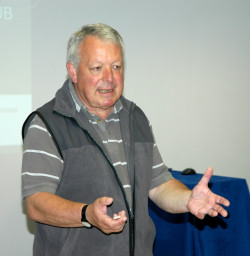Professor Patrick De Wilde from the Vrije Universiteit Brussel, Brussels (VUB) gave a lecture at Ashurst Lodge entitled “Conceptual design of light-weight structures for students of architectural engineering”.
During his presentation, Patrick discussed how to teach to architects the basic concepts of structures. The difference in Patrick’s view is that while architectural engineers ‘design’, the engineers tend to ‘analyse’. This means that the teaching differs considerably from one group to another. Patrick discussed the following points:
 Architectural Engineer versus Civil Engineer
Architectural Engineer versus Civil Engineer - Structural Design versus Structural Analysis
- Conceptual Design of Structures
- “A priori” optimisation tools
- Design for strength (ULS)
- Design for stiffness (SLS)
- Design for stability (buckling)
- Understanding the principles of structural optimization
- Design for re-use, adaptability and evolution in time.
The process of design is actually studied "from cradle to grave". Architects usually stop any further considerations at the time the building is completed. At VUB we advocate the "cradle to cradle" approach. A “four-dimensional” designer accepts that not only building materials and components depend on time, but that also the context of the building will change during its lifetime. A dynamic answer is required, wherein buildings, components and materials support the process of changing events, instead of creating end products.
The re-use of components and recycling of materials is most important and is becoming very effective in the construction industry. New concepts such as de-construction are now making an impact in modern architecture.
Patrick presented some interesting case studies discussing how to reuse exciting structures rather than demolishing them, with particular reference to social housing. This also included work carried out in Kenya where Patrick’s students are designing an optimum solution for a bridge joining a village to a nearby hospital. The design should be based on ecologically friendly materials such as bamboo canes.

 Wessex Institute
Wessex Institute